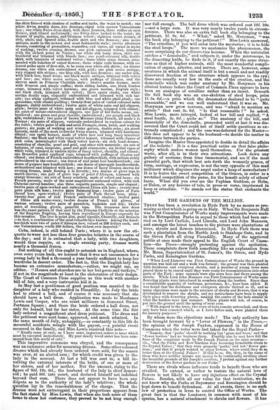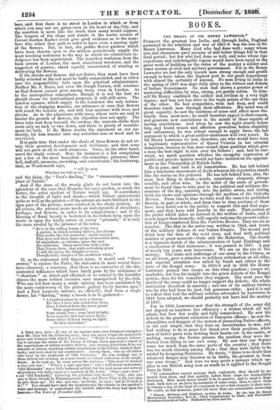THE GARDENS OF THE MILLION.
THERE has been a revolution in Hyde Park by no means so pro- mising as that which is going on in Italy. When Sir Benjamin Hall was First Commissioner of Works many improvements were made in the Metropolitan Parks in Bevel to those which had been car- ried on by Lord Carlisle, Lord Lincoln, and Lord John Manners, and amongst the latest touches to the picture were plantations of trees, shrubs and flowers intermixed. In Hyde Park there was such a plantation from the Marble Arch to Stanhope Gate, and in the Green Park all along Piccadilly. Many of the aggrieved public at once made their appeal to the English Court of Cases- tion—the Times—strongly protesting against the spoliation. These complaints drew forth something like an explanation from Mr. Mann, Superintendent of St. James's, the Green, and Hyde Parks, and Kensington Gardens.
" When Lord Llanover was First Commissioner of Works the ground in question was laid out and a walk was formed ; the ground was then planted with deciduous and evergreen shrubs, and a number of young trees were placed there to be reared until they were ready for transplantation into other parts of the Park ; some annuals were also sown here and there among the shrubs. While Lord John Manners was First Commissioner of Works some flowering plants were introduced in numbers along the borders. Since then a considerable quantity of verbenas, geraniums, &c., have been added. It was found that the deciduous and evergreen shrubs thrived so ill, and so many objections were made to the mixture of shrubs and flowers, that it was determined to remove the shrubs, and my instructions have been to supply their place with flowering plants, making the centre of the beds similar to what the borders were last summer. These plants will not, of course, be put into the ground until the spring of next year. " With regard to the trees, two rows of trees remain untouched, and those only have been removed which, as I have before said, were planted there for nursery purposes."
By whom were the objections made ? The only authority has been brought forward by a " Lover of Flowers," in the Times,— the opinion of Sir Joseph Paxton, expressed in the House of Commons when the votes were last taken for the Royal Parks- " Namely, that ' parks' should be nothing but grass and trees,' and that flower borders' had no business there. Possibly also be may have felt the force of the complaint made by Sir Joseph Paxton on the same occasion— viz., that the Parks and Kew Gardens were becoming formidable rivals to the Crystal Palace ; ' that they were properly 'parks,' and not flower gar- dens ; ' and that if people wanted to enjoy flowers, where could they do BO better than at the Crystal Palace ? If this be so, Sir, then, in the name of those who have neither leisure nor money to be continually strolling about the beautiful grounds of Sir Joseph's creation, I protest against any further destruction of the flower gardens in our Parks."
There are rivals whose influence tends to benefit those who are rivalled. To extend, or rather to restore the natural love of flowers is not likely to have any injurious effect on the Crystal Palace. Besides, with all our value for that institution, we do not know why the Parks at Bayswater and Kensington should be kept down to benefit Sydenham. At all events, there is no each law of protection in force to control the Office of Works. The great fact is that the Londoner, in common with most of his species, has a natural attachment to shrubs and flowers. It has
been said that there is no street in London in which or from which you may not see green even in the heart of the City, and the assertion is more like the truth than many would suppose. The keepers of the shops and stands in the centre avenue of Covent Garden Market could give good evidence as to the num- bers who select that path in order to have even a passing sight of the flowers. But, in fact, the public flower gardens which have been thrown open to the million gratuitously supply the most touching testimony to the way in which the considerate in- dulgence has been appreciated. The humblest workman from the back streets of London, the most abandoned wanderer, and the raggedest of gamins, stand equally unconvicted of stealing or destroying the flowers. If the shrubs and flowers did not thrive, they must have been badly selected or the soil must be badly compounded, and in either case the responsibility falls upon the practical administrator. Neither Mr. J. Mann, nor even Sir Joseph Paxton, will convince us that flowers cannot grow among trees, even in London. As to the metropolitan atmosphere, though it is not the best we should choose for horticultural purposes, it will still serve. The London squares, which supply to the Londoner the only intima- tion of the changing seasons, are witnesses at once that flowers will stand the London air, and will bear mixture with trees and shrubs. As to the admixture with trees, whose roots are said to hinder the growth of flowers, the objection does not apply. The trees take root deep beneath the surface, the annuals strike their roots only an inch or two down, and there is plenty of nourish- ment for both. If Mr. Mann doubts the statement on our au- thority, let him wander into any suburban lane or wood and be convinced.
It is quite true that under the shade of trees flowers do not at- tain their greatest development and brilliancy, and that some will not grow at all in such situations. Some, on the other hand, covet the shady retreat. Here for instance is a list comprising not a few of the most beautiful—the celandine, primrose, blue- bell, daffodil, anemone, snowdrop, and eonvolvulus ; the buttercup, that, as Wordsworth says,
" will be seen
Whether we will or no ; "
and the daisy, the " Poet's darling," the " unassuming common- place of Nature."
And if the stars of the woody glade do not burst into the splendour of the suns that illumine the open garden, so much the better, the artist student of Nature would say. It contributes to the breadth of light and shade, which Nature understands quite as well as the painter,—if the colours are more brilliant in the open part of the picture, more subdued in the shady portion. At all events, the natural scene needs an undergrowth of shrubbery, herbage, and flowers, in order to its completeness ; and if the blessing of floral beauty is bestowed in its richest form upon the rustic or upon the lordly owner of sunny "grounds," it is only the more needed by the prisoner of the town.
" Ev'n in the stifling bosom of the town
A garden, in which nothing thrives, has charms That soothe the rich possessor ; much consoled That here and there some sprigs of mournful mint, Of nightshade, or valerian, grace the spot He cultivates. These serve him with a hint That Nature lives ; that sight-refreshing green Is still the livery she delights to wear, Though sickly samples of the exuberant whole."
If, as the statesman told Queen Anne, it would cost "three crowns" to enclose the Parks, the statesmen in more recent times have observed, e converse, that there is no corrective of the dis- contented influences which have lately gone by the nickname of " chartism " so direct and effectual as to extend to the humbler classes the more refined luxuries onee monopolized by the rich. Who can tell how many a crude opinion has been conciliated by the mute controversy of the picture gallery freely thrown open ? And a Poet Laureate informs us, officially, that from a single flower, his "darling," many a lesson is to be gathered-
" A hundred times by rock or bower,
Ere thus I have lain couched an hour, Have I derived from thy sweet power Some apprehension ; Some steady love ; some brief delight; Some memory that had taken flight; Some chime of fancy wrong or right; Or stray invention."



























 Previous page
Previous page